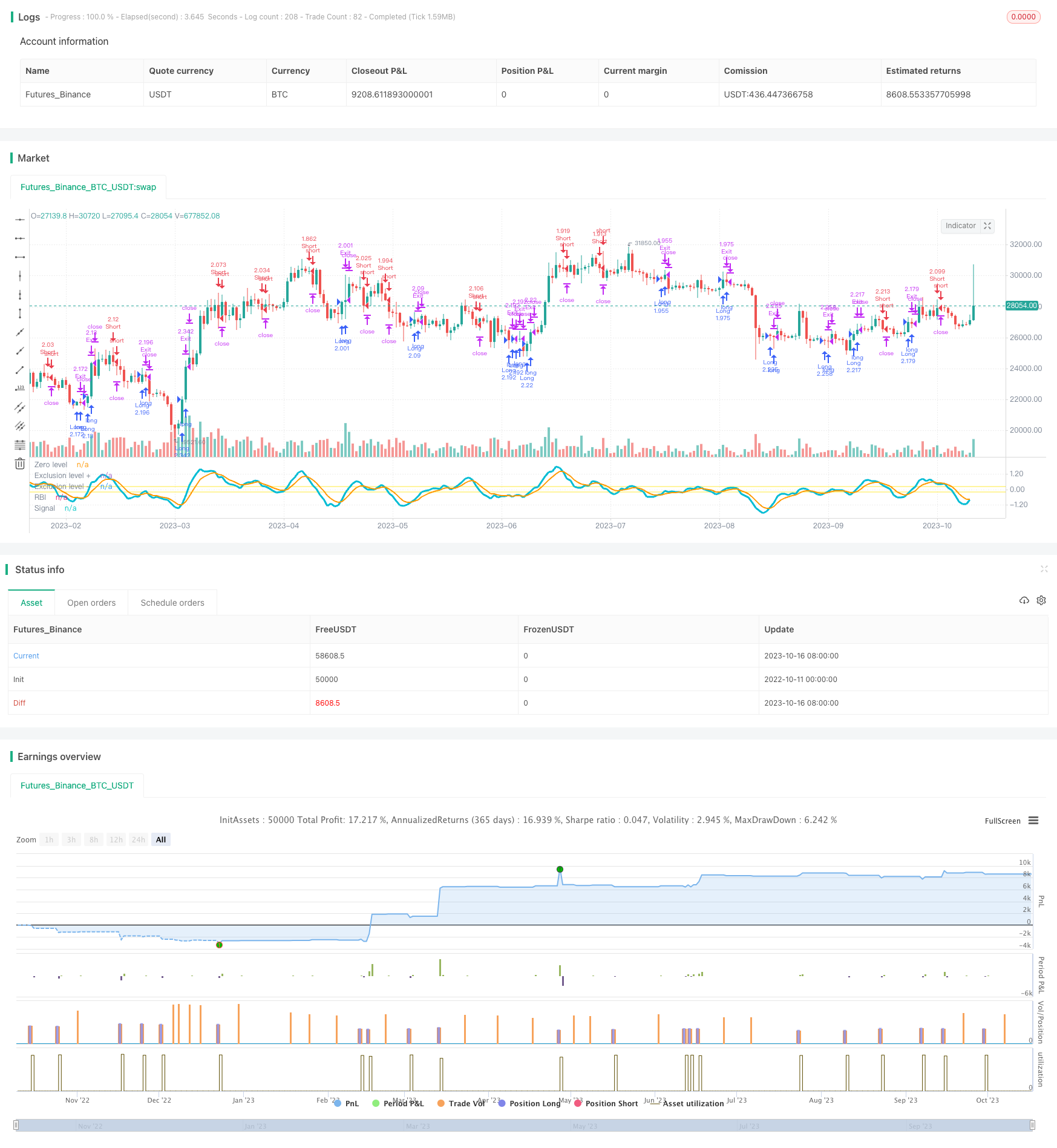
概述
这个策略主要利用日线的相对笔体比率(RB)的均线交叉信号来判断趋势,并配合止损和止盈进行自动交易。策略名称中的“相对笔涨幅”指的是计算日线相对笔体涨幅的均线。
策略原理
该策略基于Vitelot的RBI指标,该指标计算的是日K线的相对笔体比率(RB)的移动平均。RB的计算方式是:
公式里,RB等于亚阳线的实体长度与整根K线长度之比,取正值;阴线的RB取负值。RB的取值范围在-1至1之间。
RBI指标通过RB的移动平均来过滤噪音,捕捉市场的本质特征。当RBI指标上穿其信号线时产生买入信号;当RBI指标下穿信号线时产生卖出信号。
为过滤掉多头不确定阶段的虚假信号,该策略在RBI指标上穿信号线时,还会判断收盘价是否高于13周期的EMA均线,若高于才产生真正的买入信号执行多头策略。类似地,只有收盘价低于13周期EMA时,才会执行空头策略。
该策略还设置了止损和止盈机制,以控制风险和锁定利润。开仓后会trail跟踪设置的止盈点数,同时设定固定点数的止损。
优势分析
RBI指标过滤了大量噪音,能捕捉市场趋势特征,避免被震荡市场的假信号误导。
结合均线过滤,能有效避免多头不确定时段的虚假信号,减少空头亏损。
止损止盈设置有助于降低个别仓位的损失风险,同时锁定利润,整体提高盈利率。
该策略参数较少,容易理解,适合用于自动交易。
风险分析
该策略仅基于RBI指标,如果指标本身产生错误信号,则整体策略也会失败。
指标参数设置不当也可能导致交易信号质量下降。
任何技术指标都可能在特定市况下失效,无法完全避免亏损。
止损点设置过小可能导致止损过于频繁;止损点过大又可能扩大单笔损失。
回撤控制不够可能导致账户爆仓风险。
优化方向
可以测试不同的参数组合,优化RBI指标的parameter。
可以加入其它辅助指标进行过滤,提高信号质量。
可以通过机器学习训练优化止损止盈的参数。
可以加入资金管理策略,控制整体仓位和风险敞口。
可以尝试不同持仓时间的策略,如隔夜持仓或短线交易。
总结
该策略整体来说是一个较为简单直接的趋势跟踪策略。它通过计算日线相对笔体比率的均线交叉来判断趋势方向,同时加入均线过滤和止损止盈来控制风险,可以有效避免震荡市的假信号。但任何技术指标策略都无法完全规避风险,仍需要注意参数优化、风险控制等方面的持续改进优化,才能获得长期稳定的 excess return。整体来说,该策略逻辑清晰、易于理解,适合自动交易,是一个非常实用的趋势跟踪策略。
/*backtest
start: 2022-10-11 00:00:00
end: 2023-10-17 00:00:00
period: 1d
basePeriod: 1h
exchanges: [{"eid":"Futures_Binance","currency":"BTC_USDT"}]
*/
//@version=3
strategy("RBI Backtest /w TSSL", shorttitle="RBI Strategy", overlay=false, default_qty_type = strategy.percent_of_equity, default_qty_value = 100, initial_capital = 10000, slippage = 5)
// RBI:
// The EMA of the relative body (RB) of Japanese candles is evaluated.
// The RB of a candle (my definition) is simply the ratio of the body with respect to its full length
// and taken positive for bull candles and negative for bear candles:
// e.g. a bull "marubozo" has RB=1 a bear "marubozo" has RB=-1;
// a "doji" has RB=0.
// This simple indicator grasps the essence of the market by filtering out a great deal of noise.
//
// A flag can be selected to calculate its very basic binary version, where a bull candle counts as a one
// and a bear candle counts as a minus one.
//
// Enter (or exit) the market when the signal line crosses the base line.
// When the market is choppy we have a kind of alternating bear and bull candles so that
// RBI is FLAT and usually close to zero.
// Therefore avoid entering the market when RBI is FLAT and INSIDE the Exclusion level.
// The exclusion level is to be set by hand: go back in history and check when market was choppy; a good
// way to set it is to frame the oscillations of RBI whe price was choppy.
//
// RBI is more effective when an EMA of price is used as filtering. I found EMA(13) to be
// a decent filter: go long when base crosses signal upwards AND closing price is above EMA(13);
// same concept for going short.
//
// As any other indicator, use it with responsibility: THERE CAN'T BE A SINGLE MAGIC INDICATOR winning
// all trades.
//
// Above all, have fun.
//
// Vitelot/Yanez/Vts March 31, 2019
par1 = input(5, title="MA1 Period")
par2 = input(5, title="Signal Period")
exclusion = input(0.2, title="Exclusion level")
useBin = input(false, title="Calculate the binary version")
treshold_long = input(0, title="Treshold Long")
treshold_short = input(0, title="Treshold Short")
fixedSL = input(title="SL Activation", defval=300)
trailSL = input(title="SL Trigger", defval=1)
fixedTP = input(title="TP Activation", defval=120)
trailTP = input(title="TP Trigger", defval=1)
FromMonth = input(defval = 1, title = "From Month", minval = 1, maxval = 12)
FromDay = input(defval = 1, title = "From Day", minval = 1, maxval = 31)
FromYear = input(defval = 2019, title = "From Year", minval = 2017)
ToMonth = input(defval = 6, title = "To Month", minval = 1, maxval = 12)
ToDay = input(defval = 19, title = "To Day", minval = 1, maxval = 31)
ToYear = input(defval = 2020, title = "To Year", minval = 2017)
start = timestamp(FromYear, FromMonth, FromDay, 00, 00) // backtest start window
finish = timestamp(ToYear, ToMonth, ToDay, 23, 59) // backtest finish window
startTimeOk() => true // create function "within window of time" if statement true
ynSimple(t) =>
s = (close>open)? 1: -1
ema(sum(s,t),t)
ynRel(t) =>
s = (close-open)/(high-low)
ema(sum(s,t),t)
yn = useBin? ynSimple(par1): ynRel(par1)
sig = ema(yn,par2)
plot(yn, color=aqua, title="RBI", linewidth=3, transp=0)
plot(sig, color=orange, title="Signal", linewidth=2, transp=0)
hline(0, color=white, title="Zero level", editable=false)
hline(exclusion, color=yellow, title="Exclusion level +", editable=true, linestyle=line)
hline( 0-exclusion, color=yellow, title="Exclusion level -", editable=true, linestyle=line)
long = crossover(yn,sig) and yn < treshold_long
short = crossover(sig,yn) and yn > treshold_short
// === STRATEGY - LONG POSITION EXECUTION ===
strategy.entry("Long", strategy.long, when= long and startTimeOk())
strategy.exit("Exit", qty_percent = 100, loss=fixedSL, trail_offset=trailTP, trail_points=fixedTP)
strategy.exit("Exit", when= short)
// === STRATEGY - SHORT POSITION EXECUTION ===
strategy.entry("Short", strategy.short, when= short and startTimeOk())
strategy.exit("Exit", qty_percent = 100, loss=fixedSL, trail_offset=trailTP, trail_points=fixedTP)
strategy.exit("Exit", when= long)